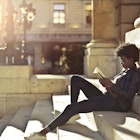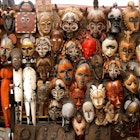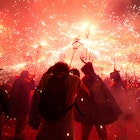
Dec 23, 2020 • 1 min read

'Perceiving Freedom', a controversial public artwork in Cape Town. Image by Simon Richmond / Lonely Planet
Cape Town’s streets and parks are filled with public art installations, many of them commemorating South Africa’s troubled past. Some are embraced by the citizens, others have provoked heated reactions from Capetonians that don’t always see eye to eye with the artists.

The most polarising of works has been Michael Ellion’s Perceiving Freedom, a giant metal and plastic pair of Ray Bans, sponsored by the eyeware company and said by the artist to have been inspired by Nelson Mandela, who was once photographed wearing a pair of the sunshades.
When the work was unveiled on Sea Point promenade, looking out to Robben Island, in November 2014 there were howls of protest. The local press dismissed it as ‘corporate vandalism’ rather than art, by the end of the month the sculpture had been vandalised by the guerrilla graffito group Tokolos-stencils, notorious for their ‘disruptions’ of Cape Town’s colonial and apartheid era statues. The sculpture was swiftly cleaned up and the sign board detailing its meaning was removed, leaving the vast majority of people who pose for photos or climb atop and over the giant frames little wiser on the controversy they had caused.

Ellion is far from alone among Capetonian artists who have upset the establishment and/or the public. Africa by Brett Murray was a controversial winner of a public sculpture competition in 1998. It took a year for lawyers to fight off opposition from some city counselors against the 3m-tall bronze fetish figure studded with yellow Bart Simpson heads. Murray said he was depicting Africa as a dumping ground for Western culture; 21 years later it remains in situ on St George’s Mall, an artistic curiosity that few locals give a second glance to.
You might also like: African art capital: Cape Town transformed
There’s no shortage of painful history for Cape Town to drawn on when it comes to inspiration for public art works. In Church Square is the Slavery Memorial – 11 low, black granite blocks engraved with the names of slaves or words relating to slavery, resistance and rebellion.
Opposite, a small circular plaque in the traffic island on Spin St marks the location of the original Slave Tree, long since chopped down, under which slaves were sold until emancipation in 1834.

While on Signal Hill, look out for one of the colourful mosaic benches created by Rock Girl. This inspiring project was started by human rights lawyer Michelle India Baird in 2010 when she was volunteering at the Red River School in the crime ridden Cape Flats suburb of Manenberg. There was an urgent need there to create safe places for young girls and boys to sit and not be harassed by gangsters.
Several prominent Capetonian artists and designers have since become involved in creating the benches, of which there are currently 60. Most of those in Central Cape Town are twinned with a sister bench in the townships, such as Gugulethu, where there’s one at the Amy Biehl Memorial.
In the City Bowl along St George’s Mall there’s a bench at Krotoa Place commemorating the 17th century Khoe-San woman Krotoa van Meerhof who acted as an interpreter for Jan van Riebeeck. She married a Dutch settler, but ended her life, aged just 32, imprisoned on Robben Island.
In Prestwich Memorial Garden there are three benches: Time Out by artist Paul du Toit, in the shape of a symbolic Rock Girl; an over-sized wooden bench by Mark Thomas (who also designed the Boomslang at Kirstenbosch Botanical Gardens) and a metal and wooden one by Laurie van Heerden inside Truth Coffee.
You might also like: A tale of two townships: Soweto & Khayelitsha
Kimberley-born artist Jacques Coetzer was the winner of a Western Cape Government-sponsored R1 million competition in 2014 for a permanent artwork to sit on a plinth on the corner of Dorp and Long Streets. The brief was that as well as celebrating 20 years of democracy for South Africa, the work should depict the history, diversity and future aspirations of Cape Town.
Coetzer’s Open House takes the form of a 10.5m-tall bright red house facade with stairs and balconies on three levels. It’s envisioned as a place where people can go to speak, sing, cry or simply wave to passersby. Coetzer drew inspiration from corrugated metal structures, RDP homes and Long Street itself.

Perceiving Freedom is not the only temporary installation along Sea Point prom. Pause at the powerful, thought-provoking Rhinosaur by Andre Carl van der Merwe. When you look through the cross-hairs section of this installation, the rest of it comes into view as the target: a gravely endangered rhino.
One the sea wall is the metallic sculpture Kom Oor die See by Haroon Gunn-Salie, a piece that was inspired by lyrics from the Cape Minstrels song 'Dar Kom die Alibama', celebrating the CSS Alibama’s visit to Cape Town in 1863.
A less successful visit to Table Bay by the SS South African Seafarer in 1966 is the inspiration for Kevin Brand’s permanent Five White Horses, at the Three Anchor Bay end of the promenade. When the ship ran aground some of its cargo including plastic white horses washed up on the shore nearby. Each of the askew horses has a vuvuzela horn in its mouth: speak into one horse and the sound comes out the mouth of another.
Get inspired to travel everyday by signing up to our daily newsletter.
Originally written by Simon Richmond and published in 2015, this article was updated by Lucy Corne in 2019.


Dec 23, 2020 • 1 min read

Aug 3, 2020 • 14 min read

Jul 22, 2020 • 6 min read




Jun 12, 2019 • 7 min read

